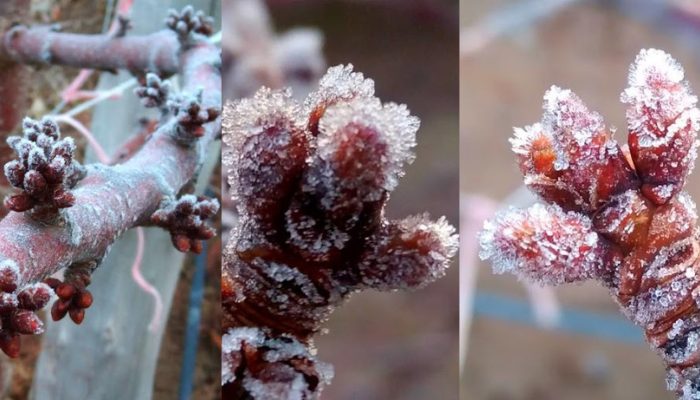The Argentinean Northern Patagonia represents a fruit-growing area of renowned prestige worldwide, both for its long history in the agro-export industry and for its exceptional agro-environmental conditions for the production of temperate-cold climate fruits. The region has a Mediterranean-continental climate with cold winters and warm, dry summers characterized by high temperature variations. Additionally, the abundant availability of meltwater from high-flow rivers not only contributes to the exceptional quality of cherries produced here but also creates an extraordinary sanitary context characterized by low or no incidence of pests and diseases. This is evidenced, for example, by the recognition of the region as a “Fruit Fly-Free Area” by the United States, China, and Chile.
Understanding dormancy as a key stage in the annual cycle that cherry trees must go through to achieve satisfactory productivity, it is possible to validate and verify that the agroclimatic attributes of this region consistently meet the requirements of this important resting period. In that sense, focusing on the transition or acclimatization that the fruit tree experiences during the late post-harvest phase, which we define as “entry into dormancy,” typically occurring during the month of April, cherry trees planted here show a marked evolution in leaf senescence (“yellowing”). This natural process occurs in response to the progressive drop in temperatures and the occurrence of the first frost of the year.
By the end of April, more than 50% of the leaves have fallen in all varieties, allowing for an early accumulation of winter chill and avoiding the need for artificial leaf drop induction strategies used in other fruit-producing regions in the southern hemisphere. This also allows for the early start of winter pruning. This is not a minor aspect when considering the current context of labor availability limitations in the fruit sector. It helps compensate for the lack of manpower by extending the time window for this important task, which has a limited timeframe for completion (Figure 1).
Figure 1: Progress of dormancy entry in a Lapins variety orchard located in the Vista Alegre area, Neuquén.





Focusing our analysis on the winter chill accumulation during the current year, it is possible to infer that, to date, the accumulated records show a slightly higher accumulation trend compared to the historical average (2003-2022 series), both in terms of chill hours (conventional method base 7.2°C) and chill units (Utah model / Richardson et al., 1974). However, it is slightly lower compared to the same date last year, which was characterized by exceptional winter chill accumulation (EEA INTA Alto Valle, 2023).
To express the current situation in numerical terms, as of July 17th, we observe that for the locality of Vista Alegre (Neuquén), the accumulated values are 816 chill hours and 766 chill units. These records represent an increase of 3.9% to 6.4% compared to 2019 and 2021, and a decrease of 7.4% to 21.3% compared to 2020 and 2022, respectively. This accumulation, to date, fulfills the total chill requirements for the Royal Dawn, Lapins, Santina, Skeena, Sweet Heart, and Bing varieties, leaving only Regina pending, considering the main cultivars planted in this region. The values related to this current situation, as well as the comparison with the past four seasons, are shown in the following tables (Tables 1 and 2).
Table 1: Winter chill accumulation (Base 7°C and Richardson methods) for the locality of Vista Alegre, Neuquén, as of 17/07/2023.
| YEAR | Chill Hours (Base 7°C) | Δ (%) | Chill Units (Richardson) | Δ (%) |
| 2019 | 785 | 3,9 | 837,5 | -8,5 |
| 2020 | 881 | -7,4 | 789,5 | -3,0 |
| 2021 | 767 | 6,4 | 681 | 12,5 |
| 2022 | 1037 | -21,3 | 867,5 | -11,7 |
| 2023 | 816 | – | 766 | – |
Table 2: Percentage of winter chill accumulation for the main cultivated varieties in Northern Patagonia, for the locality of Vista Alegre, Neuquén, as of 17/07/2023.
| CULTIVAR | CHILL REQUIREMENT | % ACCUMULATION | ||
| ChH (<7°C) | ChU (Richardson) | ChH (<7°C) | ChU (Richardson) | |
| Royal Dawn | 450 | 780,0 | 100,0 | 98,2 |
| Santina | 600 | 1040,0 | 100,0 | 73,7 |
| Lapins | 550 | 960,0 | 100,0 | 79,8 |
| Skeena | 700 | 1200,0 | 100,0 | 63,8 |
| Bing | 800 | 1380,0 | 100,0 | 55,5 |
| Regina | 1000 | 1700,0 | 81,6 | 45,1 |
| Sweet Heart | 700 | 1200,0 | 100,0 | 63,8 |
This potential for chill accumulation, characteristic of the region, allows for independence from the use of dormancy breakers to compensate for the lack of chill, as is the case in other areas, particularly early in the harvest calendar. The application of dormancy breakers in this region is more strategically focused on synchronizing flowering curves between self-sterile varieties and their pollinators and attempting to advance flowering dates (and eventually harvest), provided that the counterpart of spring thermal accumulation (degree-days from bud break) is significant enough to allow for that effect.










